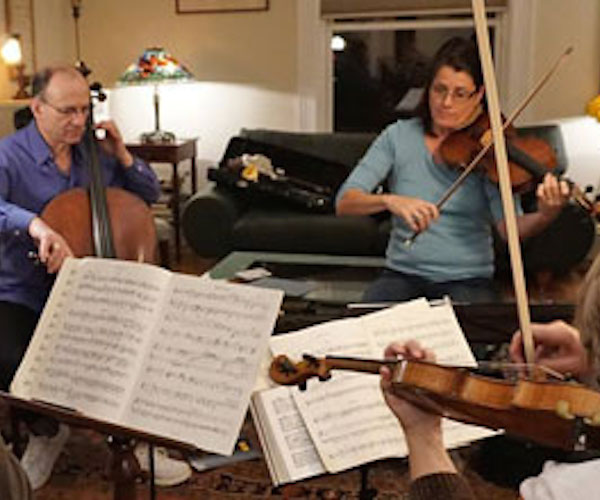Concert Review: Boston Artists Ensemble — Chamber Music Done Right
The Boston Artists Ensemble performance was full of bravado, virtuosity, subtlety, and charm.

The Boston Artists Ensemble in rehearsal.
By David Janssen
Judging by its January 10th concert, the Boston Artists Ensemble is serving up world class performances of chamber music. This was the group’s third concert of the 2015-2016 season; there will be two more additional concerts (to be held in Brookline and Salem) featuring various guest musicians. The organization was founded in 1980 by Jonathan Miller, veteran cellist of the Boston Symphony Orchestra. His aim was to provide the Boston area with top notch performances of chamber music, and this presentation more than met the challenge: it was full of bravado, virtuosity, subtlety, and charisma.
Both of the string quartets on the program, Bartók’s String Quartet No. 1 in A minor and Ravel’s String Quartet, come from the first decade of the twentieth century, a period of great compositional upheaval. Departures from the masters such as Bach, Mozart, and Beethoven led to an ambitious proliferation of various styles. These two works, though written within just a few years of each other, represent two vastly divergent approaches. In his later string quartets, Bartók took an increasingly dissonant (at times not particularly listener friendly) path, whereas Ravel continued more or less with a French Impressionist style that had been established decades earlier.
Bartók’s first quartet could be described as “Bartók-lite”; it is one of the more approachable of his works. Yet the fear engendered by the reputation of his later string quartets no doubt prompted BAE violinist Bayla Keyes to warn the audience members before the performance that it might be necessary to “endure” the first movement in exchange for the vivacious following movements. No such red flag was needed. Keyes’ deeply expressive and animated playing was matched by the second violin part (supplely performed by Lucy Chapman) in the opening fugal dialogue. The rest of the work was played supremely well, with some standout moments, especially at the climaxes, when all four voices of the quartet jelled into one.
The Ravel quartet needed no note of consumer caution. If, for some reason, you were not pulled in by the Bartók, the Ravel composition, with its lush harmonic paradise, would be impossible to resist. As gorgeous as the work may be, it is no less technically demanding than the Bartók. The virtuosity of the performers turned sounding beautiful into an easy task. Violinists Keyes, founding member of the Muir String Quartet, and Chapman, former member of the Muir String Quartet and Chair of the String Department at New England Conservatory, swapped violin roles. Keyes played first violin in the Bartók; Chapman was first violin in the Ravel. The many “cantabile” sections of the later quartet were marvelously conceived. Of particular note: the rich sounding viola of Jessica Bodner and the expert cello playing of Jonathan Miller. The performers provided seamless intonation throughout the work; their detailing was particularly impressive during very bare spots in the third movement.
Composer-Teacher David Janssen serves on the faculties of New Hampshire Institute of Art, Boston Baptist College, and Middlesex Community College teaching Music Appreciation and Theory. David’s list of works span several genres such as solo, chamber and orchestral music with performances in Prague, New York City, Boston and Oklahoma. The third movement of David’s Symphony No. 1 titled The Return of the Son of Man was a semi-finalist in the professional division of the national competition “The American Prize in Composition.” In December 2013, Canterbury Choral Society premiered David’s motet The Shepherds and the Angels in the Field. Current projects include Piano Sonata No.1, Violin and Cello Duo, and several professional recordings.
